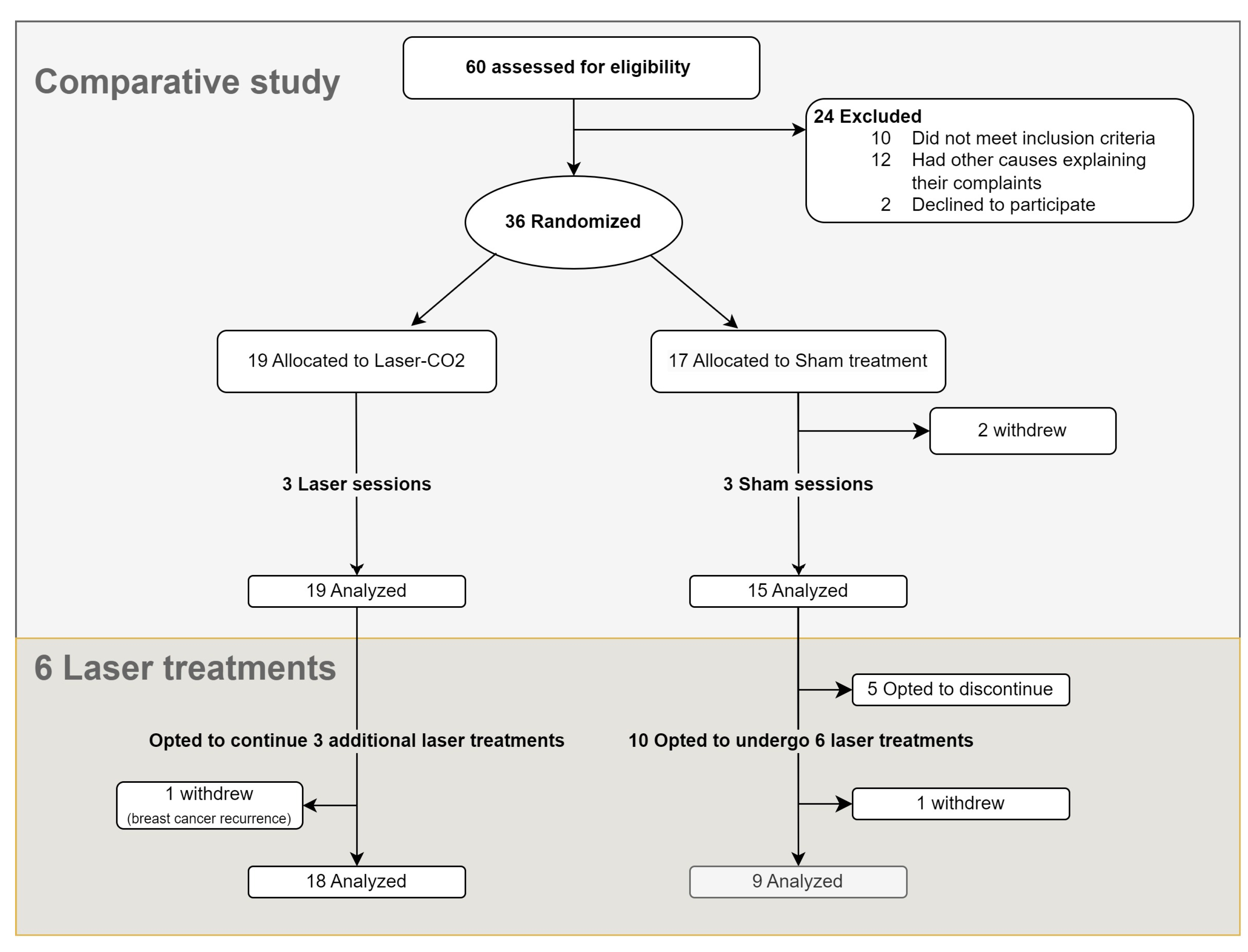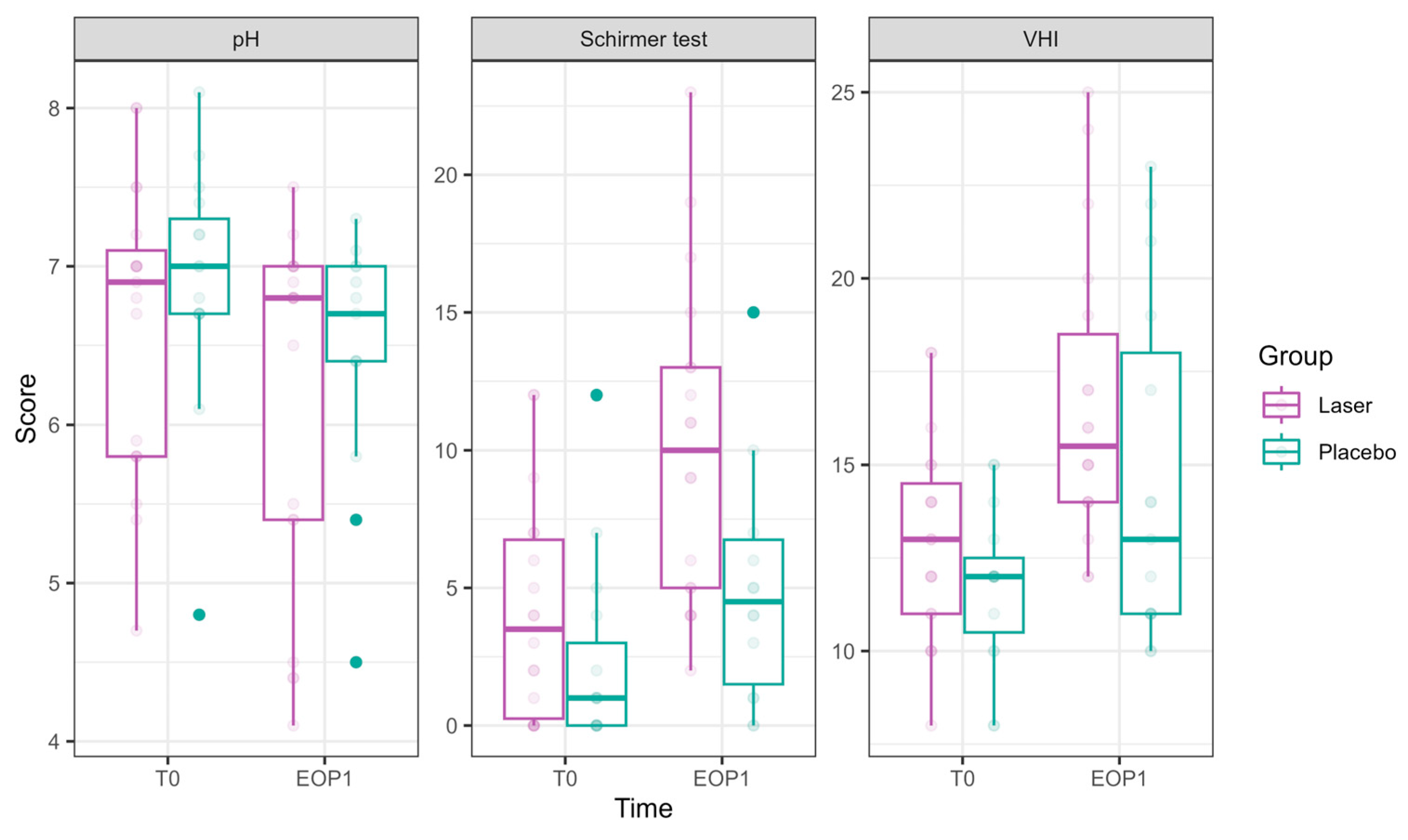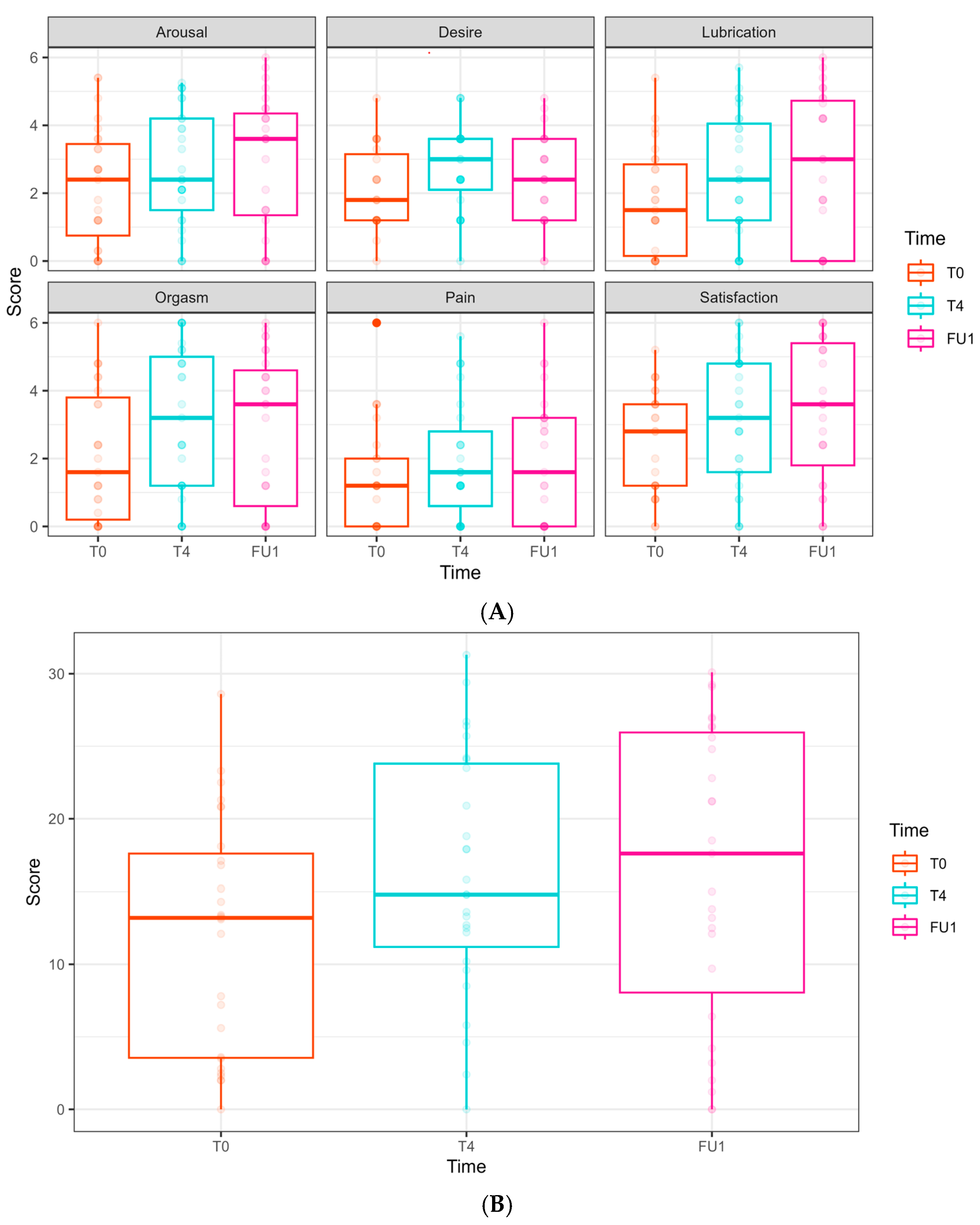CO2 Laser Therapy for Genitourinary Syndrome of Menopause in Women with Breast Cancer: A Randomized, Sham-Controlled Trial
Simple Summary
Abstract
1. Introduction
2. Materials and Methods
2.1. Study Protocol (Figure 1)

2.2. Treatment with CO2 Laser and Sham
2.3. Outcome Measures Included
- Vaginal pH: using an indicator strip (range 4–8).
- Vaginal hydration measured by the modified Schirmer test [31]: Measurement was performed by placing a calibrated filter paper strip (Schirmer tear test strips) in the vaginal introitus in a standard manner [31] for 5 min. The paper was removed, and the amount of moisture was measured in millimeters. This measure allows for the direct and objective evaluation of vaginal hydration.
- VAS assessments for GSM symptoms: Dryness during intercourse (“intercourse-dryness”), dyspareunia, daily vaginal dryness, discomfort, burning, discharge, itching, and dysuria. The severity of the symptoms was measured using an eleven-point VAS, with 0 representing “absence of symptom”, and 10 being “most severe symptom”.
- Female Sexual Function Index (FSFI): The FSFI is a nineteen-item questionnaire that assesses six domains of sexual function in women: desire, arousal, lubrication, orgasm, satisfaction, and pain. Each item is scored on a scale of 0 or 1 to 5, with higher scores indicating better sexual function. The total FSFI score ranges from 2 to 36, with a score of 26.55 or less suggesting sexual dysfunction. Both the individual domain scores and the total scores were analyzed, to provide a view of sexual function across different areas as well as the overall assessment [32]. The FSFI has been validated in BC patients [33].
2.4. Statistical Analysis
3. Results
3.1. Baseline Characteristics
3.2. Comparison of CO2 Laser to Sham (Phase 1, Three Sessions)
3.2.1. Primary Outcomes (Figure 2)

3.2.2. Secondary Outcomes (Figure 2, Figure 3 and Figure 4 and Tables S4–S6)


3.3. Outcomes of Six CO2 Laser Treatments (Phase 2)
3.3.1. Primary Outcomes (Figure 5 and Figure 6, Tables S5–S8)
3.3.2. Secondary Outcomes
4. Discussion
5. Conclusions
Supplementary Materials
Author Contributions
Funding
Institutional Review Board Statement
Informed Consent Statement
Data Availability Statement
Acknowledgments
Conflicts of Interest
Abbreviations
| AI | Aromatase inhibitors |
| BC | Breast cancer |
| EOP1 | End of phase 1 |
| FSFI | Female Sexual Function Index |
| GEE | Generalized estimating equations |
| GSM | Genitourinary syndrome of menopause |
| VAS | Visual Analogue Scale |
| VHI | Vaginal Health Index |
References
- Bosetti, C.; Bertuccio, P.; Levi, F.; Chatenoud, L.; Negri, E.; La Vecchia, C. The decline in breast cancer mortality in Europe: An update (to 2009). Breast 2012, 21, 77–82. [Google Scholar] [CrossRef] [PubMed]
- Baumgart, J.; Nilsson, K.; Stavreus-Evers, A.; Kask, K.; Villman, K.; Lindman, H.; Kallak, T.; Sundström-Poromaa, I. Urogenital disorders in women with adjuvant endocrine therapy after early breast cancer. Am. J. Obstet. Gynecol. 2011, 204, 26.e1–26.e7. [Google Scholar] [CrossRef]
- Lester, J.; Pahouja, G.; Andersen, B.; Lustberg, M. Atrophic vaginitis in breast cancer survivors: A difficult survivorship issue. J. Pers. Med. 2015, 5, 50–66. [Google Scholar] [CrossRef]
- Portman, D.J.; Gass, M.L.S. Genitourinary syndrome of menopause: New terminology for vulvovaginal atrophy from the International Society for the Study of Women’s Sexual Health and The North American Menopause Society. Menopause 2014, 21, 1063–1068. [Google Scholar] [CrossRef]
- Daly, B.; Olopade, O.I.; Hou, N.; Yao, K.; Winchester, D.J.; Huo, D. Evaluation of the Quality of Adjuvant Endocrine Therapy Delivery for Breast Cancer Care in the United States. JAMA Oncol. 2017, 3, 928–935. [Google Scholar] [CrossRef] [PubMed]
- Faubion, S.S.; Larkin, L.C.; Stuenkel, C.A.; Bachmann, G.A.; Chism, L.A.; Kagan, R.; Kaunitz, A.M.; Krychman, M.L.; Parish, S.J.; Partridge, A.H.; et al. CONSENSUS RECOMMENDATIONS: Management of genitourinary syndrome of menopause in women with or at high risk for breast cancer: Consensus recommendations from the North American Menopause Society and the International Society for the Study of Women’s Sexual. Menopause 2018, 25, 596–608. [Google Scholar] [CrossRef]
- Cella, D.; Fallowfield, L.J. Recognition and management of treatment-related side effects for breast cancer patients receiving adjuvant endocrine therapy. Breast Cancer Res. Treat. 2008, 107, 167–180. [Google Scholar] [CrossRef]
- Moegele, M.; Buchholz, S.; Seitz, S.; Lattrich, C.; Ortmann, O. Vaginal Estrogen Therapy for Patients with Breast Cancer. Geburtshilfe Und Frauenheilkd. 2013, 73, 1017–1022. [Google Scholar] [CrossRef]
- Biglia, N.; Bounous, V.E.; Sgro, L.G.; D’Alonzo, M.; Pecchio, S.; Nappi, R.E. Genitourinary Syndrome of Menopause in Breast Cancer Survivors: Are We Facing New and Safe Hopes? Clin. Breast Cancer 2015, 15, 413–420. [Google Scholar] [CrossRef]
- Qiu, S.; Arthur, A.; Jiang, Y.; Miao, Y.; Li, Y.; Wang, J.; Tadir, Y.; Lane, F.; Chen, Z. OCT angiography in the monitoring of vaginal health. APL Bioeng. 2023, 7, 046112. [Google Scholar] [CrossRef]
- Salvatore, S.; Athanasiou, S.; Candiani, M. The use of pulsed CO2 lasers for the treatment of vulvovaginal atrophy. Curr. Opin. Obstet. Gynecol. 2015, 27, 504–508. [Google Scholar] [CrossRef]
- Alcalay, M.; Ben Ami, M.; Greenshpun, A.; Hagay, Z.; Schiff, E. Fractional-Pixel CO2 Laser Treatment in Patients with Urodynamic Stress Urinary Incontinence: 1-Year Follow-Up. Lasers Surg. Med. 2021, 53, 960–967. [Google Scholar] [CrossRef] [PubMed]
- Franić, D.; Fistonić, I.; Franić-Ivanišević, M.; Perdija, Ž.; Križmarić, M. Pixel CO2 Laser for the Treatment of Stress Urinary Incontinence: A Prospective Observational Multicenter Study. Lasers Surg. Med. 2021, 53, 514–520. [Google Scholar] [CrossRef] [PubMed]
- Pieralli, A.; Fallani, M.G.; Becorpi, A.; Bianchi, C.; Corioni, S.; Longinotti, M.; Tredici, Z.; Guaschino, S. Fractional CO2 laser for vulvovaginal atrophy (VVA) dyspareunia relief in breast cancer survivors. Arch. Gynecol. Obstet. 2016, 294, 841–846. [Google Scholar] [CrossRef] [PubMed]
- Pagano, T.; De Rosa, P.; Vallone, R.; Schettini, F.; Arpino, G.; De Placido, S.; Nazzaro, G.; Locci, M.; De Placido, G. Fractional microablative CO2 laser for vulvovaginal atrophy in women treated with chemotherapy and/or hormonal therapy for breast cancer: A retrospective study. Menopause 2016, 23, 1108–1113. [Google Scholar] [CrossRef]
- Gambacciani, M.; Levancini, M. Vaginal erbium laser as second-generation thermotherapy for the genitourinary syndrome of menopause: A pilot study in breast cancer survivors. Menopause 2017, 24, 316–319. [Google Scholar] [CrossRef]
- Pagano, T.; De Rosa, P.; Vallone, R.; Schettini, F.; Arpino, G.; Giuliano, M.; Lauria, R.; De Santo, I.; Conforti, A.; Gallo, A.; et al. Fractional microablative CO2 laser in breast cancer survivors affected by iatrogenic vulvovaginal atrophy after failure of nonestrogenic local treatments: A retrospective study. Menopause 2018, 25, 657–662. [Google Scholar] [CrossRef]
- Mothes, A.R.; Runnebaum, M.; Runnebaum, I.B. Ablative dual-phase Erbium:YAG laser treatment of atrophy-related vaginal symptoms in post-menopausal breast cancer survivors omitting hormonal treatment. J. Cancer Res. Clin. Oncol. 2018, 144, 955–960. [Google Scholar] [CrossRef]
- Pearson, A.; Booker, A.; Tio, M.; Marx, G. Vaginal CO2 laser for the treatment of vulvovaginal atrophy in women with breast cancer: LAAVA pilot study. Breast Cancer Res. Treat. 2019, 178, 135–140. [Google Scholar] [CrossRef]
- Arêas, F.; Valadares, A.L.R.; Conde, D.M.; Costa-Paiva, L. The effect of vaginal erbium laser treatment on sexual function and vaginal health in women with a history of breast cancer and symptoms of the genitourinary syndrome of menopause: A prospective study. Menopause 2019, 26, 1052. [Google Scholar] [CrossRef]
- Jha, S.; Wyld, L.; Krishnaswamy, P.H. The impact of vaginal laser treatment for genitourinary syndrome of menopause in breast cancer survivors: A systematic review and meta-analysis. Clin. Breast Cancer 2019, 19, e556–e562. [Google Scholar] [CrossRef] [PubMed]
- Quick, A.M.; Zvinovski, F.; Hudson, C.; Hundley, A.; Evans, C.; Suresh, A.; Stephens, J.A.; Arthur, E.; Ramaswamy, B.; Reinbolt, R.E.; et al. Fractional CO2 laser therapy for genitourinary syndrome of menopause for breast cancer survivors. Support. Care Cancer 2020, 28, 3669–3677. [Google Scholar] [CrossRef]
- Hersant, B.; Werkoff, G.; Sawan, D.; Sidahmed-Mezi, M.; Bosc, R.; La Padula, S.; Kalsoum, S.; Ouidir, N.; Meningaud, J.P.; Belkacemi, Y. Carbon dioxide laser treatment for vulvovaginal atrophy in women treated for breast cancer: Preliminary results of the feasibility EPIONE trial. Ann. Chir. Plast. Esthet. 2020, 65, e23–e31. [Google Scholar] [CrossRef] [PubMed]
- Siliquini, G.P.; Bounous, V.E.; Novara, L.; Giorgi, M.; Bert, F.; Biglia, N. Fractional CO2 vaginal laser for the genitourinary syndrome of menopause in breast cancer survivors. Breast J. 2021, 27, 448–455. [Google Scholar] [CrossRef]
- Ruanphoo, P.; Bunyavejchevin, S. Treatment for vaginal atrophy using microablative fractional CO2 laser: A randomized double-blinded sham-controlled trial. Menopause 2020, 27, 858–863. [Google Scholar] [CrossRef]
- Cruff, J.; Khandwala, S. A Double-Blind Randomized Sham-Controlled Trial to Evaluate the Efficacy of Fractional Carbon Dioxide Laser Therapy on Genitourinary Syndrome of Menopause. J. Sex. Med. 2021, 18, 761–769. [Google Scholar] [CrossRef] [PubMed]
- Salvatore, S.; Pitsouni, E.; Grigoriadis, T.; Zacharakis, D.; Pantaleo, G.; Candiani, M.; Athanasiou, S. CO2 laser and the genitourinary syndrome of menopause: A randomized sham-controlled trial. Climacteric J. Int. Menopause Soc. 2021, 24, 187–193. [Google Scholar] [CrossRef]
- Li, F.G.; Maheux-Lacroix, S.; Deans, R.; Nesbitt-Hawes, E.; Budden, A.; Nguyen, K.; Lim, C.Y.; Song, S.; McCormack, L.; Lyons, S.D.; et al. Effect of Fractional Carbon Dioxide Laser vs Sham Treatment on Symptom Severity in Women with Postmenopausal Vaginal Symptoms: A Randomized Clinical Trial. JAMA 2021, 326, 1381–1389. [Google Scholar] [CrossRef]
- Page, A.S.; Verbakel, J.Y.; Verhaeghe, J.; Latul, Y.P.; Housmans, S.; Deprest, J. Laser versus sham for genitourinary syndrome of menopause: A randomised controlled trial. BJOG Int. J. Obstet. Gynaecol. 2023, 130, 312–319. [Google Scholar] [CrossRef]
- Bachmann, G. Urogenital ageing: An old problem newly recognized. Maturitas 1995, 22, S1–S5. [Google Scholar] [CrossRef]
- Gabrieli, D.; Suissa-Cohen, Y.; Jaber, S.; Lev-Sagie, A. “Modified Schirmer Test” as an Objective Measurement for Vaginal Dryness: A Prospective Cohort Study. Diagnostics 2022, 12, 574. [Google Scholar] [CrossRef] [PubMed]
- Rosen, C.B. The Female Sexual Function Index (FSFI): A Multidimensional Self-Report Instrument for the Assessment of Female Sexual Function. J. Sex Marital. Ther. 2000, 26, 191–208. [Google Scholar] [CrossRef] [PubMed]
- Bartula, I.; Sherman, K.A. The Female Sexual Functioning Index (FSFI): Evaluation of acceptability, reliability, and validity in women with breast cancer. Support. Care Cancer 2015, 23, 2633–2641. [Google Scholar] [CrossRef]
- Mension, E.; Alonso, I.; Anglès-Acedo, S.; Ros, C.; Otero, J.; Villarino, Á.; Farré, R.; Saco, A.; Vega, N.; Castrejón, N.; et al. Effect of Fractional Carbon Dioxide vs Sham Laser on Sexual Function in Survivors of Breast Cancer Receiving Aromatase Inhibitors for Genitourinary Syndrome of Menopause: The LIGHT Randomized Clinical Trial. JAMA Netw. Open 2023, 6, e2255697. [Google Scholar] [CrossRef] [PubMed]
- Nappi, R.E.; Martini, E.; Cucinella, L.; Martella, S.; Tiranini, L.; Inzoli, A.; Brambilla, E.; Bosoni, D.; Cassani, C.; Gardella, B. Addressing Vulvovaginal Atrophy (VVA)/Genitourinary Syndrome of Menopause (GSM) for Healthy Aging in Women. Front. Endocrinol. 2019, 10, 561. [Google Scholar] [CrossRef]
- Falk, S.J.; Bober, S. Vaginal Health During Breast Cancer Treatment. Curr. Oncol. Rep. 2016, 18, 32. [Google Scholar] [CrossRef]
- Quick, A.M.; Zvinovski, F.; Hudson, C.; Hundley, A.; Evans, C.; Suresh, A.; Stephens, J.A.; Arthur, E.; Ramaswamy, B.; Reinbolt, R.E.; et al. Long-Term Follow-Up of Fractional CO2 Laser Therapy for Genitourinary Syndrome of Menopause in Breast Cancer Survivors. J. Clin. Med. 2022, 11, 774. [Google Scholar] [CrossRef]
- Becorpi, A.; Campisciano, G.; Zanotta, N.; Tredici, Z.; Guaschino, S.; Petraglia, F.; Pieralli, A.; Sisti, G.; De Seta, F.; Comar, M. Fractional CO2 laser for genitourinary syndrome of menopause in breast cancer survivors: Clinical, immunological, and microbiological aspects. Lasers Med. Sci. 2018, 33, 1047–1054. [Google Scholar] [CrossRef]
- Haenen, V.; Dams, L.; Meeus, M.; Devoogdt, N.; Morlion, B.; De Groote, A.; De Groef, A. Continuum of somatosensory profiles in breast cancer survivors with and without pain, compared to healthy controls and patients with fibromyalgia. Eur. J. Pain 2024, 28, 1226–1241. [Google Scholar] [CrossRef]
- Haenen, V.; Dams, L.; Meeus, M.; De Groef, A. Altered somatosensory functioning and mechanism-based classification in breast cancer patients with persistent pain. Anat. Rec. 2024, 307, 273–284. [Google Scholar] [CrossRef]



| Characteristics | Laser (n = 19) | Sham (n = 15) | p Value |
|---|---|---|---|
| Age | 45 [40.75–53] | 47 [42–54.5] | 0.509 |
| Tobacco use | 1 (5.3%) | 1 (5.6%) | >0.99 |
| Comorbidities | 4 (21.1%) | 4 (26.7%) | >0.99 |
| Menopause cause | 0.493 | ||
| Spontaneous | 3 (15.8%) | 5 (33.3%) | |
| Surgical | 2 (10.5%) | 3 (20.0%) | |
| Chemotherapy | 9 (47.4%) | 4 (26.7%) | |
| Medical | 5 (26.3%) | 3 (20.0%) | |
| Years of menopause | 0.732 | ||
| <2 | 6 (31.6%) | 3 (20.0%) | |
| 2–5 | 7 (36.8%) | 6 (40.0%) | |
| >5 | 6 (31.6%) | 6 (40.0%) | |
| Gravity | 4 [2–4] | 4 [3–4.5] | 0.606 |
| Parity | 3 [2–3] | 3 [2–3] | 0.686 |
| Vaginal deliveries | 2 [1–3] | 2 [0–3] | 0.696 |
| Body mass index | 24.12 [22.3–25.3] | 24.4 [22–28.0] | 0.5374 |
Disclaimer/Publisher’s Note: The statements, opinions and data contained in all publications are solely those of the individual author(s) and contributor(s) and not of MDPI and/or the editor(s). MDPI and/or the editor(s) disclaim responsibility for any injury to people or property resulting from any ideas, methods, instructions or products referred to in the content. |
© 2025 by the authors. Licensee MDPI, Basel, Switzerland. This article is an open access article distributed under the terms and conditions of the Creative Commons Attribution (CC BY) license (https://creativecommons.org/licenses/by/4.0/).
Share and Cite
Jaber, S.; Levin, G.; Ram-Weiner, M.; Lev-Sagie, A. CO2 Laser Therapy for Genitourinary Syndrome of Menopause in Women with Breast Cancer: A Randomized, Sham-Controlled Trial. Cancers 2025, 17, 1241. https://doi.org/10.3390/cancers17071241
Jaber S, Levin G, Ram-Weiner M, Lev-Sagie A. CO2 Laser Therapy for Genitourinary Syndrome of Menopause in Women with Breast Cancer: A Randomized, Sham-Controlled Trial. Cancers. 2025; 17(7):1241. https://doi.org/10.3390/cancers17071241
Chicago/Turabian StyleJaber, Sireen, Gabriel Levin, Maya Ram-Weiner, and Ahinoam Lev-Sagie. 2025. "CO2 Laser Therapy for Genitourinary Syndrome of Menopause in Women with Breast Cancer: A Randomized, Sham-Controlled Trial" Cancers 17, no. 7: 1241. https://doi.org/10.3390/cancers17071241
APA StyleJaber, S., Levin, G., Ram-Weiner, M., & Lev-Sagie, A. (2025). CO2 Laser Therapy for Genitourinary Syndrome of Menopause in Women with Breast Cancer: A Randomized, Sham-Controlled Trial. Cancers, 17(7), 1241. https://doi.org/10.3390/cancers17071241







